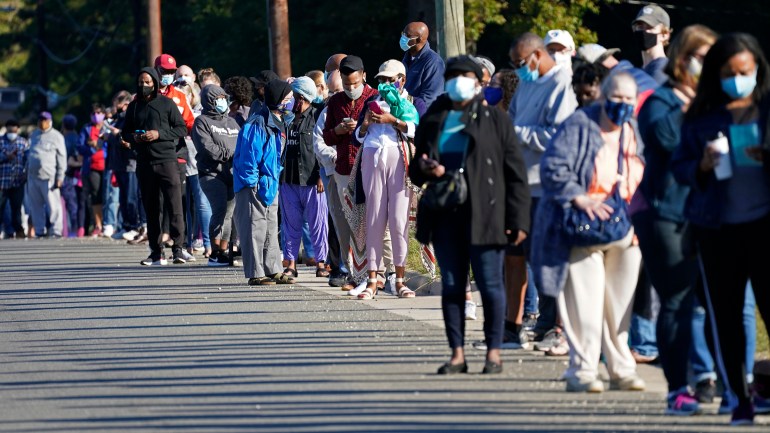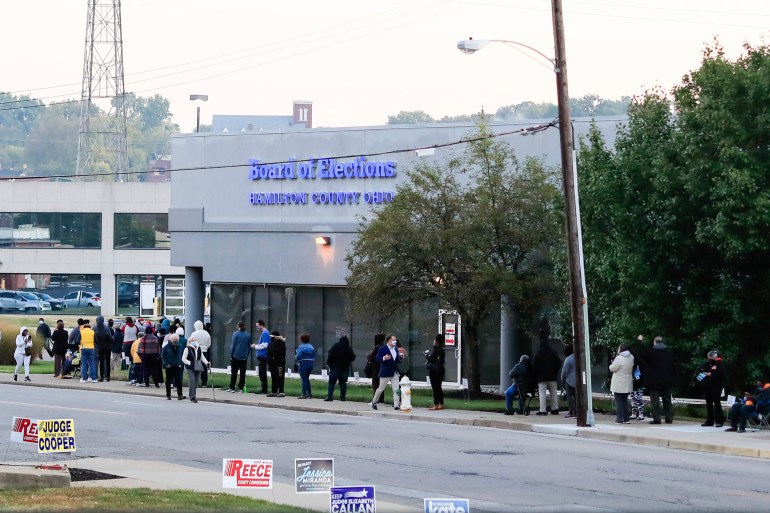Early voting has started in more than 20 states ahead of the November 3 United States presidential election and already, the turnout has far surpassed past contests, leading some experts to project record-breaking participation this year.
More than 25 million ballots have been cast through in-person early ballots and mail-in voting as of Saturday, the United States Election Project said, which corresponds to more than 18 percent of all the votes counted in the 2016 presidential race.
But that early voter engagement, in part fuelled by the COVID-19 pandemic, has also led to new challenges, as long lines and hours-long waits were reported at polling sites in Georgia, Texas, North Carolina, Tennessee, Louisiana and Ohio, among other states.
 Early voters line up to cast their ballots at the South Regional Library polling location in Durham, North Carolina [Gerry Broome/AP]
Early voters line up to cast their ballots at the South Regional Library polling location in Durham, North Carolina [Gerry Broome/AP]
The time-consuming process has been attributed to enthusiasm in a charged political climate, eagerness to avoid the polls on election day because of the novel coronavirus, and, in some cases, glitches with the voting infrastructure.
But it is also evidence of barriers that many US voters face, according to voting rights advocates, who said that those barriers, which can make casting a ballot a day-long affair, often disproportionately affect minority communities.
Critics also said that some voting systems, which are overseen by and differ between each respective US state, even in national elections, are inherently designed to help one party over the other.
“The long lines are happening not by accident but design,” the National Election Defence Coalition, a group of election-monitoring organisations, tweeted on October 15. “Voters must stand up to defend our system of government.”
Fewer polling places
In Georgia, where polls opened on Monday, some voters waited more than eight hours to cast their votes, according to local media.
The first day of voting in the state saw 128,000 residents go to the polls, smashing 2016’s first-day turnout of 91,000, The Associated Press news agency reported.
State officials said the turnout was “extreme and tremendous” and, therefore, lines were to be expected. “There’s a lot of enthusiasm around this election, and you’re going to see high turnout. Because of that, we’re going to see lines,” Deputy Secretary of State Jordan Fuchs told the Atlanta Journal-Constitution newspaper.
During Georgia primary voters in predominantly white areas waited 6 minutes to vote while voters in predominantly minority areas waited 51 minutes to vote
Voter suppression in Georgia direct result of SCOTUS gutting Voting Rights Act & would be even worse if Barrett confirmed https://t.co/Twb5F7rvVo
— Ari Berman (@AriBerman) October 12, 2020
The delays were partially fuelled by problems with voter check-in computers at polling sites in the Atlanta area, according to local media.
But an analysis by Georgia Public Broadcasting and ProPublica, published Saturday in coordination with National Public Radio, indicated a more insidious problem: A shrinking number of polling sites in the state.
The news outlets reported that while the reduction of polling places has taken place “across racial lines”, it has had an outsized effect on nonwhite communities that have seen spikes in voter registration and where residents are more likely to cast ballots in person.
Another day of early voting and another long line in NC. This one in Durham. Polls open right now pic.twitter.com/6PDD9fn2Ha
— Leigh Ann Caldwell (@LACaldwellDC) October 17, 2020
That’s particularly noteworthy, as Georgia is one of several places in the US with a history of voter discrimination. Under the landmark Voting Rights Act of 1965, the state had been required to get federal preclearance before making changes to its voting systems and infrastructure.
However, a Supreme Court ruling in 2013 eliminated that requirement, allowing state officials and legislators to make changes to how voting is carried out without oversight by the federal government. Individuals and groups can still challenge state voting practices in court.
Since then, the number of registered voters in Georgia has grown by nearly two million people, while the number of polling locations has been cut statewide by 10 percent, according to the Georgia Public Broadcasting and ProPublica analysis.
 More than 25 million ballots have been cast through in-person early ballots and mail-in voting as of Saturday, the United States Election Project said [File: LM Otero/AP]
More than 25 million ballots have been cast through in-person early ballots and mail-in voting as of Saturday, the United States Election Project said [File: LM Otero/AP]
Nine counties in the city of Atlanta have been hit particularly hard, accounting for half of the state’s voters, but only 38 percent of its polling places, the report found, although some have sought to make last-minute polling site additions before the election.
It also said the average number of voters per polling place increased by 40 percent in those counties from 2012 to October 9. Across Georgia, about 90 percent of precincts do not adhere to a state law that caps the number of voters allowed to cast their ballots at a single polling site that has previously experienced voter delays at 2,000 people.
The high number of voters using a single polling site extends beyond Georgia, a June voting analysis by the Brennan Center for Justice, a public policy institute at New York University Law School, found.
The average number of voters assigned to polling places also increased during the last five years in Louisiana, Mississippi and South Carolina, all states that previously required preclearance under the Voting Rights Act.
Unequal resources
Other US states, including those that did not have special requirements under the Voting Rights Act, have also been accused of using long waits at polling sites to suppress voters.
In Ohio, where early voting began on October 6, the number of people who cast ballots in person during the first week of early voting nearly tripled compared with 2016, with 193,021 voters going to the polls compared with 64,312 four years ago.
 More than 193,000 people cast ballots in person during the first week of early voting this month in Ohio, nearly triple the number who cast early ballots in that same period in 2016 [File: Aaron Doster/AP]
More than 193,000 people cast ballots in person during the first week of early voting this month in Ohio, nearly triple the number who cast early ballots in that same period in 2016 [File: Aaron Doster/AP]
The surge led to hours-long waits at polling stations, including a line of voters in the city of Columbus that stretched about 0.4 kilometres (0.25 miles) on the first day the polls opened, the AP reported.
Ohio state officials have blamed the long lines on the first day of early voting on high “enthusiasm” among the electorate.
But a 2006 state law that limits early, in-person polling sites to one per county also contributed to the long line-ups, former President Barack Obama’s speechwriter, David Litt, noted this week in The Guardian newspaper.
Litt said the set-up means that residents of Vinton County, a Republican bastion with a population of 13,500, have access to the same number of early voting sites as the 1.3 million residents of Franklin County, which encompasses Columbus, the state capital.
This line is for early voting in Columbus – yay #Ohio #VOTE 👊🏽 pic.twitter.com/0ZY0QArZ02
— Ashley Koff RD (@ashleykoff) October 12, 2020
“Blaming voters for the long lines they endure ignores the massive, intentional disparity in resources between the more and less populous parts of the state,” Litt wrote. “Ohio’s politicians have made voting far easier for Republicans and far more difficult for Democrats.”
